Over the last month, conservation has been playing host to two rather notorious and unsavoury characters, namely William Burke and William Hare. Thankfully for us not in person but rather in the form of a scrapbook containing original documents and cuttings from their capture and subsequent trail and execution.
The most interesting and macabre of all of these is a letter written in the blood of William Burke – as it (helpfully) states “This is a letter written with the blood of Wm. Burke, who was hanged at Edinburgh on 28th Jan. 1829 for the Murder of Mrs. Campbell or Docherty. The blood was taken for his head on the 1st of Feb. 1829.” Unsurprisingly, the scrapbook, and this letter in particular, has caused a lot of attention, and has recently appearing in a number of newspaper and websites. I have found myself in the rather unusual position of combining conservation with press calls – the conservation life is not always quite so glamorous!
The scrapbook has a pamphlet style of binding with the cuttings pasted into its pages, the larger of which have been folded in order to fit within the volume. Overall, the scrapbook was in a reasonable condition and it was decided therefore to take a minimal interventive conservation approach with treatment focused on surface cleaning, tear repair where necessary and rehousing. The aim was to stabilise the object allowing it to be stored and accessed with minimal risk, at the same time as maintaining its authenticity.
The first stage of treatment was to surface clean the pages. This was done with “chemical sponge” – made of vulcanised rubber which (despite its name) contains no chemicals – which works by gently lifting off any surface dirt on the pages. This has not only aesthetic benefits but, more importantly, will remove any potentially damaging substrates. Surface dirt can contain acidic particulates, cause abrasions, attract moisture, and become a food source of mould, all of which can affect the long-term preservation of the object.
Secondly, I carried out tear repairs where necessary using Japanese tissue and wheat starch paste. The tears where primarily on the larger format cuttings that had been folded in position within the scrapbook and found in areas where the paper had become weak, especially along the folds or along edges where the cutting has projected beyond the edge of the scrapbook. Again, as with surface cleaning, repairing tears will not only improve the appearance of the pages, but will also provide structural stability making the paper easier to handle and reduce the risk of the tear getting caught and becoming worse.

After tear repair
The last stage in treatment, and arguably the most important, was to address the housing needs of the scrapbook. As well as providing physical support to the item, choosing appropriate storage has the added benefits of giving an extra layer of protection from accidental damage, as well as acting as a buffer to atmospheric pollutants, dust and light, and any fluctuations in environmental conditions. It is important to know and understand what the materials you are using are made from as poor quality materials that are in close contact with collection items can cause severe damage. Acid from these materials can migrate to the object causing discolouration and embrittlement and hastening the its deterioration.
I decided, therefore, to house the detached, fragile and vulnerable front and back covers of the scrapbook in polyester sleeves allowing them to be easily consulted without being removed and so would drastically improve handling whilst minimising the risk of any tears getting worse. Because of the poor quality and acidic nature of the paper cuttings contained within the scrapbook, the individual pages were interleaved with a light-weight acid-free paper to reduce the transfer of any potential harmful elements within the sheets. The scrapbook itself – alongside some loose-sheet material contained within – were rehoused in acid-free paper folders which, in turn, were placed inside a four-flap enclosure made from acid-free card.
And the blood letter? Well, it is certainly not every day that I come across something so unusual, interesting and, quite frankly, a little unsettling. However, by applying general conservation principles of minimal treatment and the use high-quality and appropriate conservation and rehousing materials, I was able to treat the letter, and scrapbook as a whole, very much like other paper-based material. Perhaps with just a little more murder and intrigue this time…
Post by Emma Davey, Conservation Officer

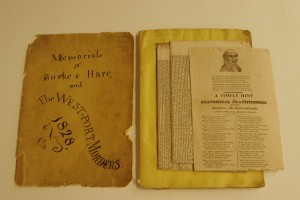
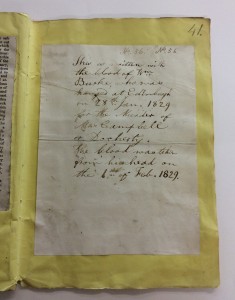
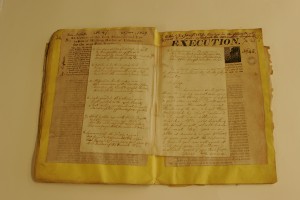
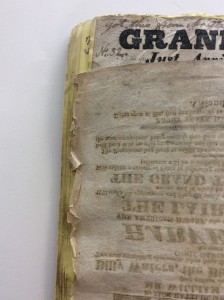
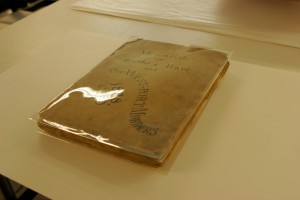
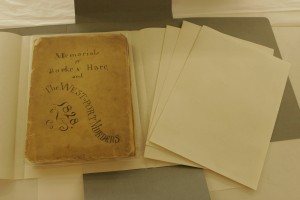
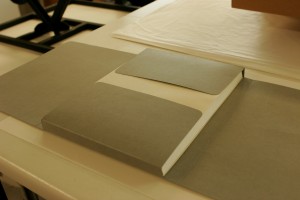
Hi Emma,
I’m currently trying to collect some case studies of blood-writings on paper as a part of a paper conservation dissertation idea, and think this could be a really fantastic object to investigate!
Did you do a condition report on the item that could be available to read?
I’m interested in how the blood might have impacted the paper and contributed to its overall condition and ageing process.
Any further information you have surrounding the condition you found the letter in, concerns you have/had for it, and any other conservation related information would be extremely interesting and useful!
All the best,
Lydia Powell